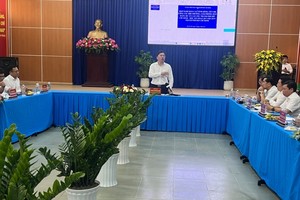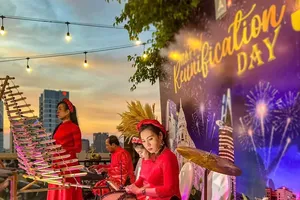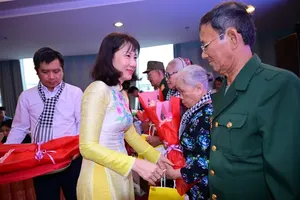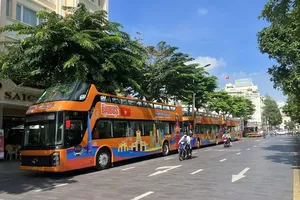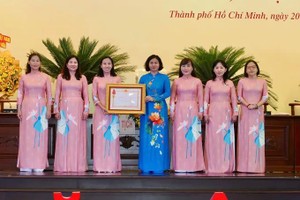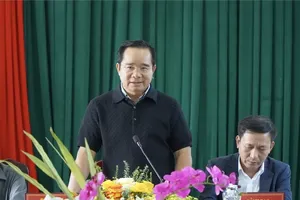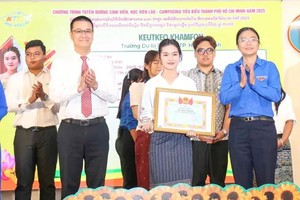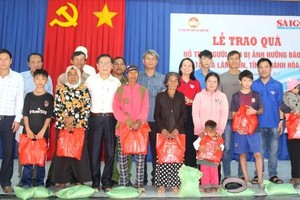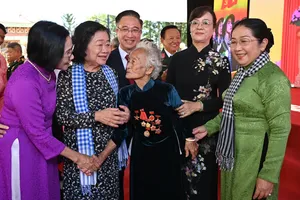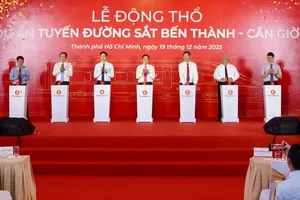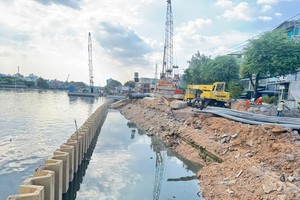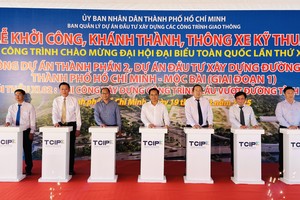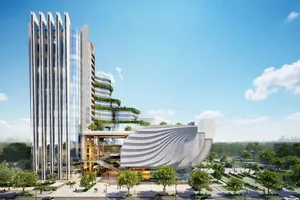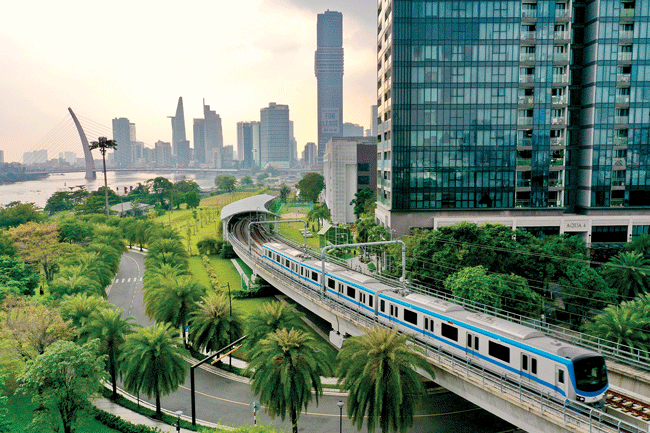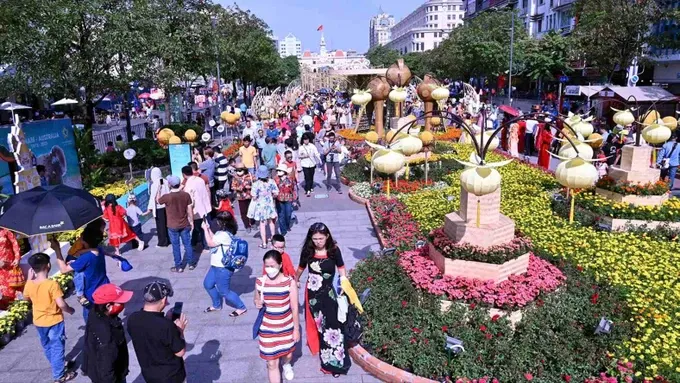
Nguyen Hue Flower Street: Cherished touchstone of HCMC identity
Hoang Thi Thanh Kieu, a resident of Germany, captures this sentiment expressively: “No Tet homecoming is complete without a visit to Nguyen Hue Flower Street. For us, children of HCMC living abroad, it's an essential ritual.” Even before Tet, her friends in Germany inquire if she has visited the flower street yet. Despite sometimes being rushed, she ensures she at least passes by to snap a photo with the zodiac animal at the entrance.
This sentiment extends beyond the diaspora. For countless city dwellers, Nguyen Hue Flower Street has become the indication of spring, a vibrant “swallow announcing the season”. Ngoc Dung, an office worker in District 1, reflects, “The relentless pace of work often makes me lose track of time. Then, suddenly, passing Nguyen Hue, I see the barricades going up for the flower street construction, and it jolts me – Tet is here!”
For Tran Manh Dung, an electrical engineer from Go Vap District, the flower street holds poignant memories. Having lost a loved one during the Covid-19 pandemic, he brought his family to the Year of the Tiger 2022 flower street seeking solace. However, seeing it enclosed with restricted access due to pandemic measures triggered his grief. “Then came the Year of the Cat 2023”, he recounts, “and stepping onto the flower street, witnessing the vibrant energy and joyous throngs of people, I was overcome with emotion. This scene felt like a powerful affirmation that the dark days were truly behind us.”
From suffering to peace: Hoa Binh Theater
Similarly, embodying a journey from loss toward peace stands Hoa Binh Theater (Peace Theater). Inaugurated on April 26, 1985 – the 10th anniversary of Southern Vietnam’s liberation and national reunification – this cultural landmark at the address of 240-242 on 3 Thang 2 Street in District 10 was conceived by the esteemed late Deputy Prime Minister and architect Huynh Tan Phat, alongside architect Nguyen Thanh The.
Spanning 16,500m2 with nearly 2,500 seats, Hoa Binh Theater quickly became a cultural icon of the city. Its stage has witnessed pivotal moments in HCMC’s history, hosting countless artistic performances, receptions, and cultural exchanges. During challenging times, it even served as a cinema, providing much-needed entertainment. Though time has taken its toll on the facility, for generations who have lived and loved HCMC, Hoa Binh Theater remains a potent symbol of a city that transcended war to embrace peace.
Dam Sen Cultural Park: From swamp to cultural oasis
Affectionately known as the “Green Oasis in the Heart of HCMC”, Dam Sen Cultural Park began as a wild, untamed swamp with natural lotus ponds – the very origin of its name, “Dam Sen” (Lotus Swamp). The vision to transform this marshland into a cultural park took root in 1976, when the HCMC People’s Committee launched a land reclamation initiative.
Thousands of citizens, Youth Volunteers, and various social organizations engaged in public service labor, diligently reshaping the area. The task was arduous given the swampy terrain and scarcity of modern equipment, but an unwavering spirit of unity gradually brought the project to fruition.
On November 29, 1989, Dam Sen Cultural Park officially opened, initially named simply “Dam Sen Park”. While early iterations featured primarily green spaces, a lake, and simple amusements, the park underwent continuous expansion. By 1998, it was rechristened “Dam Sen Cultural Park”, underscoring its expanded role not just as an entertainment venue but as a vital center for preserving Vietnamese cultural values.
Annual events like the Spring Flower Festival have become integral, solidifying the park’s cultural significance. From a neglected swamp, Dam Sen Cultural Park has blossomed into a symbol of transformation and an indispensable destination for HCMC residents.
HCMC Book Street: Cultural innovation
HCMC Book Street stands as a remarkable feat, materializing from concept to reality in merely six months. Initially, many doubted its potential success, with numerous book businesses withdrawing support at the last minute. Even after inauguration, public unfamiliarity with this novel cultural model led many to believe the Book Street would be short-lived.
However, since its official opening on January 9, 2016, the Book Street was recognized as one of HCMC’s top ten notable events in its first year. Its success extends beyond cultural impact, hosting hundreds of events and attracting hundreds of thousands of readers, to the economic sphere.
Businesses here reported revenues between VND24 and 44 billion (US$926,000 – 1.7 million) annually from 2017 to 2021, surging to nearly VND52 billion ($2 million) in 2022 and maintaining strong figures above VND57 billion ($2.2 million) in subsequent years. Today, the HCMC Book Street is not just a cultural asset but a model numerous localities across Vietnam have sought to emulate.
Historical anchors of identity
As a city deeply imbued with the nation’s history, HCMC’s cultural landmarks are inextricably linked to pivotal historical milestones. The War Remnants Museum, established a mere few months after liberation (September 4, 1975), has gradually become a top destination offering insights into the past and powerful reminders of peace's enduring value.
Similarly, the HCMC Children’s House, established just a month after national reunification (June 1, 1975), holds a special place in the city’s heart. Its main building, featuring distinctive classical French architecture, served generations as a cherished “childhood home”. In 2015, it was meticulously restored, becoming the Traditional House of the Ho Chi Minh Young Pioneer Organization, while the area behind developed into a new complex catering to children’s evolving needs.
The statue of President Ho Chi Minh standing before the municipal People’s Committee headquarters embodies the people’s profound gratitude for their great leader. Unveiled on the 125th anniversary of President Ho Chi Minh’s birth in 2015, the 7.2-meter monument depicts Uncle Ho gently waving, conveying benevolence and warm affection. Since its unveiling, the statue has become not only a place of solemn remembrance but also an appealing destination contributing to the education of patriotic traditions and affirming HCMC’s enduring historical value.
